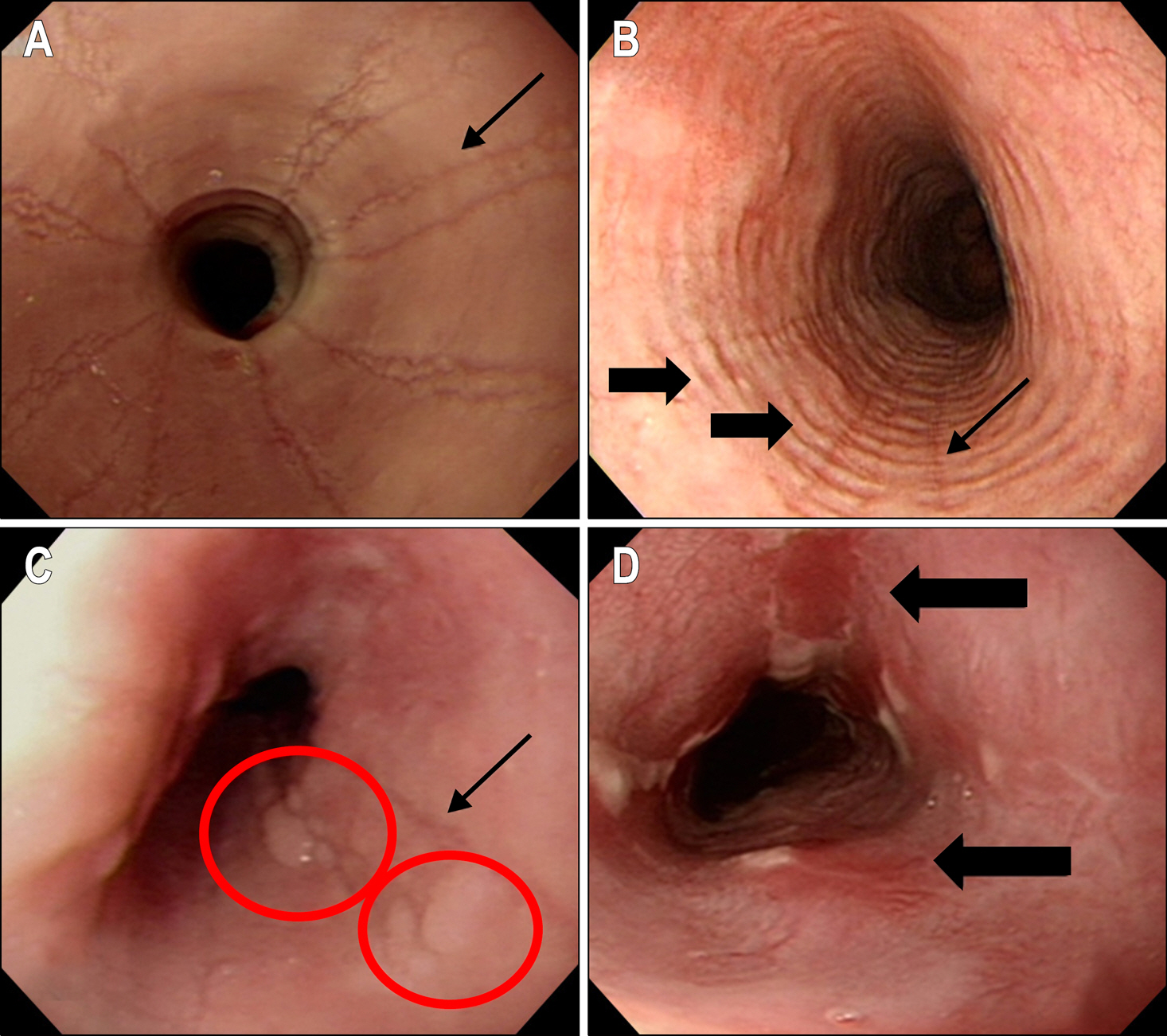Korean J Gastroenterol.
2010 Nov;56(5):285-292. 10.4166/kjg.2010.56.5.285.
Clinical Implications of Endoscopically Suspected Eosinophilic Esophagitis
- Affiliations
-
- 1Department of Internal Medicine, Gangnam Severance Hospital, Yonsei University College of Medicine, Seoul, Korea. HJPARK21@yuhs.ac
- KMID: 1718369
- DOI: http://doi.org/10.4166/kjg.2010.56.5.285
Abstract
- BACKGROUND/AIMS
We aimed to determine the concordance rate and clinical predictors of eosinophilic esophagitis (EoE) in patients with endoscopically suspected eosinophilic esophagitis (ESEoE) findings.
METHODS
From June 2006 to December 2009 in Gangnam Severance Hospital, we prospectively enrolled the patients of "endoscopically suspected eosinophilic esophagitis (ESEoE)", and then we retrospectively reviewed and analyzed clinical features and endoscopic findings.
RESULTS
We found 17 patients of ESEoE, and 5 of them were finally confirmed as an EoE by histology (diagnostic concordance rate 29.4%). We added two more patients previously diagnosed as EoE and compared patients of EoE+ (n=7) with EoE- (n=12). Mean age was 56.0 (range 36-70) and 51.0 (range 36-68) years old, respectively. In EoE+ group, there were 5 males and 2 females and 6 males and 6 females in EoE- group. The symptoms of EoE+ patients were dysphagia (n=5), food impaction (n=3), foreign body sensation in esophagus (n=2), chest pain (n=1), and heartburn (n=1). EoE- patients complained food impaction (n=5), heartburn (n=4), chest pain (n=2), foreign body sensation in esophagus (n=2), and dysphagia (n=1). The endoscopic findings of EoE+ patients were furrows (n=6), rings (n=5), exudates or nodules (n=3), and friability (n=1). EoE- patients showed rings (n=10) and furrows(n=7). Univariative analysis showed that 'a symptom of dysphagia', 'presence of exudates or nodules', 'more than 2 suggestive endoscopic findings' were significantly different between two groups.
CONCLUSIONS
In ESEoE, diagnostic concordance rate was 29.4%. In addition, 'symptom of dysphagia', 'exudates or nodules', '> or =2 endoscopic findings' are more suggestive of EoE in ESEoE patients.
Keyword
Figure
Reference
-
1. Landres RT, Kuster GG, Strum WB. Eosinophilic esophagitis in a patient with vigorous achalasia. Gastroenterology. 1978; 74:1298–1301.
Article2. Attwood SE, Smyrk TC, Demeester TR, Jones JB. Esophageal eosinophilia with dysphagia. A distinct clinicopathologic syndrome. Dig Dis Sci. 1993; 38:109–116.3. Kim JW, Park JS, Kim YH, et al. Secondary achalasia by eosinophilic esophagitis. Korean J Gastrointest Endosc. 2002; 25:198–202.4. Lee B, Park H, Yoon H, Kim HK, Kim HS. Three cases of eosinophilic esophagitis with dysphagia as a chief complaint. Korean J Gastrointest Endosc. 2008; 36:145–149.5. Furuta GT, Liacouras CA, Collins MH, et al. Eosinophilic esophagitis in children and adults: a systematic review and consensus recommendations for diagnosis and treatment. Gastroenterology. 2007; 133:1342–1363.
Article6. Potter JW, Saeian K, Staff D, et al. Eosinophilic esophagitis in adults: an emerging problem with unique esophageal features. Gastrointest Endosc. 2004; 59:355–361.
Article7. Straumann A, Spichtin HP, Grize L, Bucher KA, Beglinger C, Simon HU. Natural history of primary eosinophilic esophagitis: a follow-up of 30 adult patients for up to 11.5 years. Gastroenterology. 2003; 125:1660–1669.
Article8. Croese J, Fairley SK, Masson JW, et al. Clinical and endoscopic features of eosinophilic esophagitis in adults. Gastrointest Endosc. 2003; 58:516–522.
Article9. Prasad GA, Talley NJ, Romeo Y, et al. Prevalence and predictive factors of eosinophilic esophagitis in patients presenting with dysphagia: a prospective study. Am J Gastroenterol. 2007; 102:2627–2632.
Article10. Veerappan GR, Perry JL, Duncan TJ, et al. Prevalence of eosinophilic esophagitis in an adult population undergoing upper endoscopy: a prospective study. Clin Gastroenterol Hepatol. 2009; 7:420–426.
Article11. Yu YH, Jo YJ, Jung MY, et al. Prevalence of eosinophlic esophagitis with dysphagia and reflux related symptoms in Korean patients. Korean J Neurogastroenterol Motil. 2009; 15:15–22.12. Park HJ. Eosinophilic esophagitis. Korean J Gastroenterol. 2007; 50:286–291.13. Sgouros SN, Bergle C, Mantides A. Eosinophilic esophagitis in adults: what is the clinical significance? Endoscopy. 2006; 38:515–520.
Article14. Dellon ES, Gibbs WB, Fritchie KJ, et al. Clinical, endoscopic, and histologic findings distinguish eosinophilic esophagitis from gastroesophageal reflux disease. Clin Gastroenterol Hepatol. 2009; 7:1305–1313.
Article15. Putnam PE, Rothenberg ME. Eosinophilic esophagitis: concepts, controversies, and evidence. Curr Gastroenterol Rep. 2009; 11:220–225.
Article16. Lim JR, Gupta SK, Croffie JM, et al. White specks in the esophageal mucosa: An endoscopic manifestation of non-reflux eosinophilic esophagitis in children. Gastrointest Endosc. 2004; 59:835–838.
Article17. Katzka DA. Demographic data and symptoms of eosinophilic esophagitis in adults. Gastrointest Endosc Clin N Am. 2008; 18:25–32.
Article
- Full Text Links
- Actions
-
Cited
- CITED
-
- Close
- Share
- Similar articles
-
- CT Findings of Eosinophilic Esophagitis: Case Report
- Clinical Review of Eosinophilic Esophagitis
- Three Cases of Eosinophilic Esophagitis with Dysphagia as a Chief Complaint
- Changing Concept of the Prevalence of Eosinophilic Esophagitis: Visible and Hidden Patients
- Two Cases of Eosinophilic Esophagitis Treated with a Proton Pump Inhibitor and a Systemic Steroid




